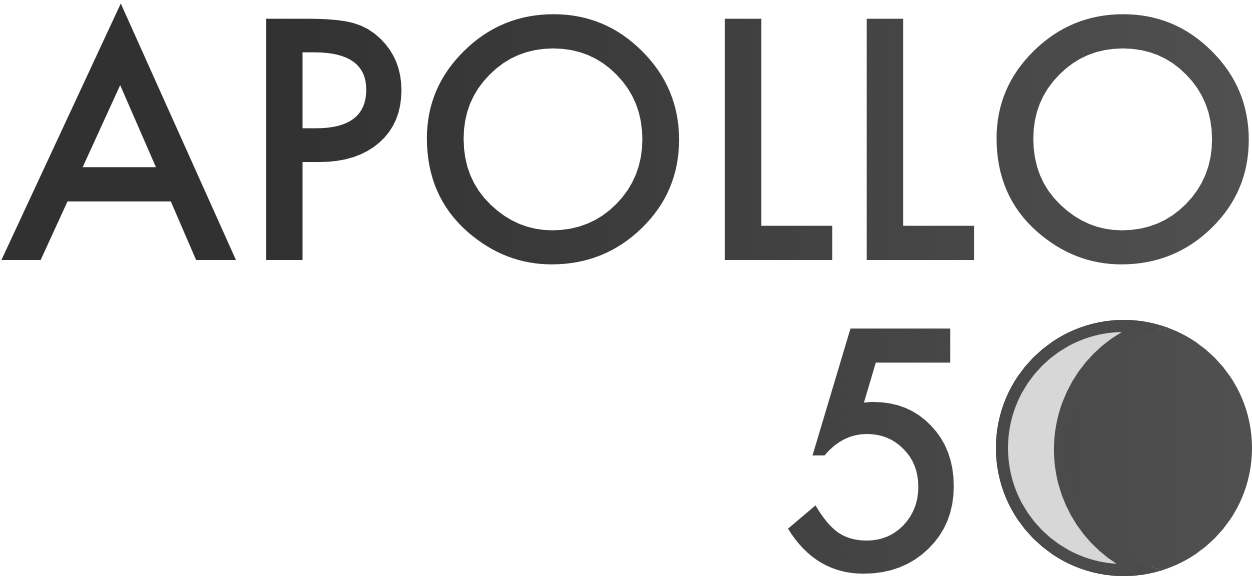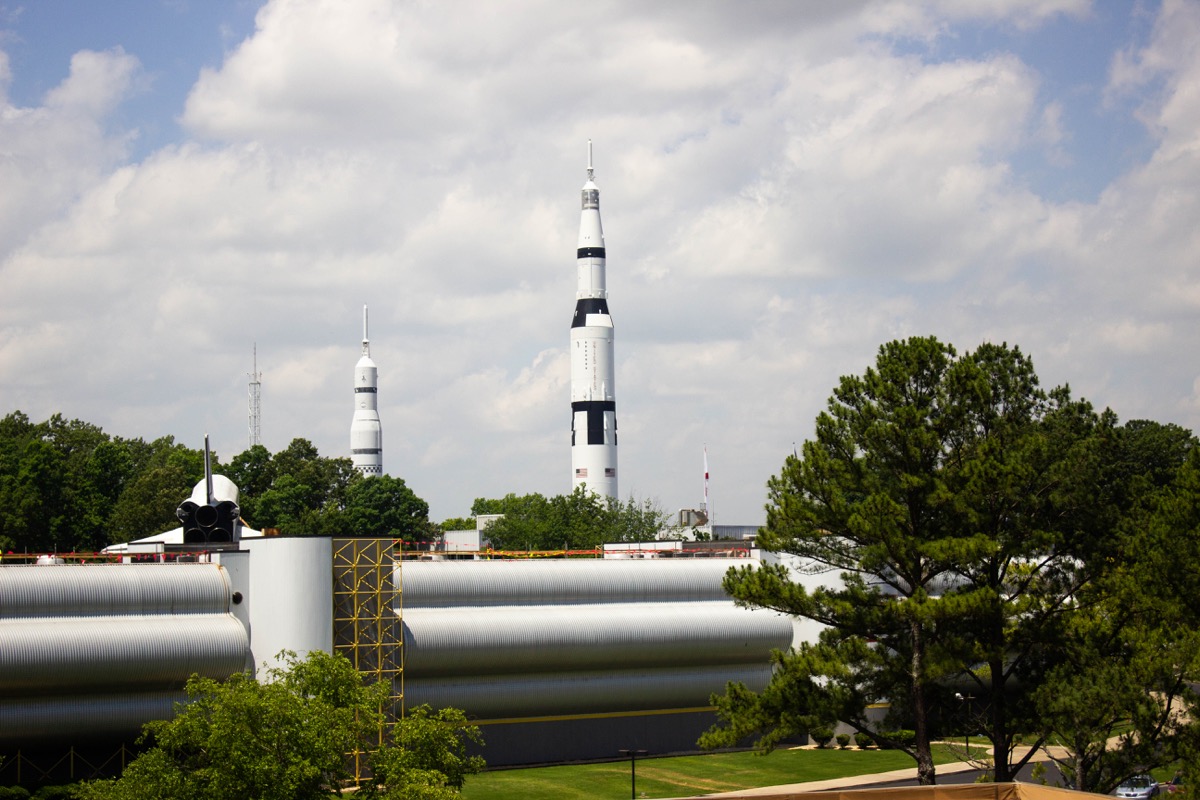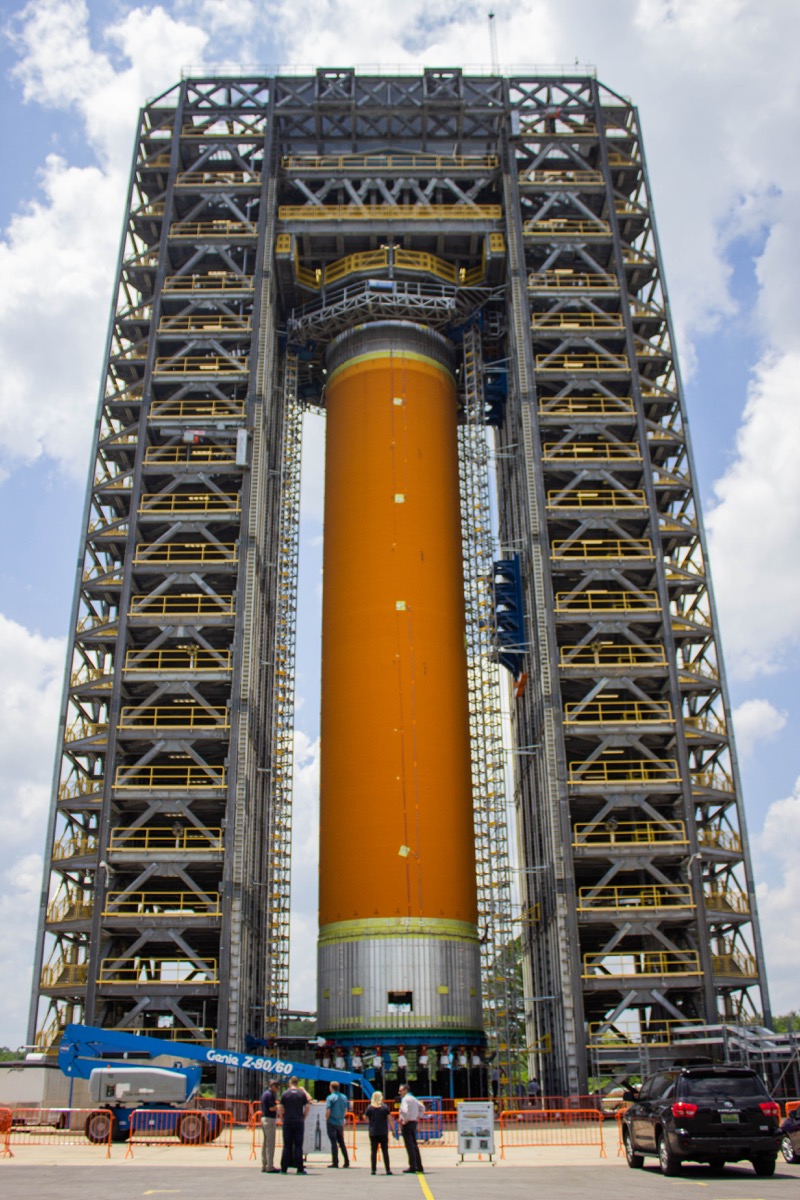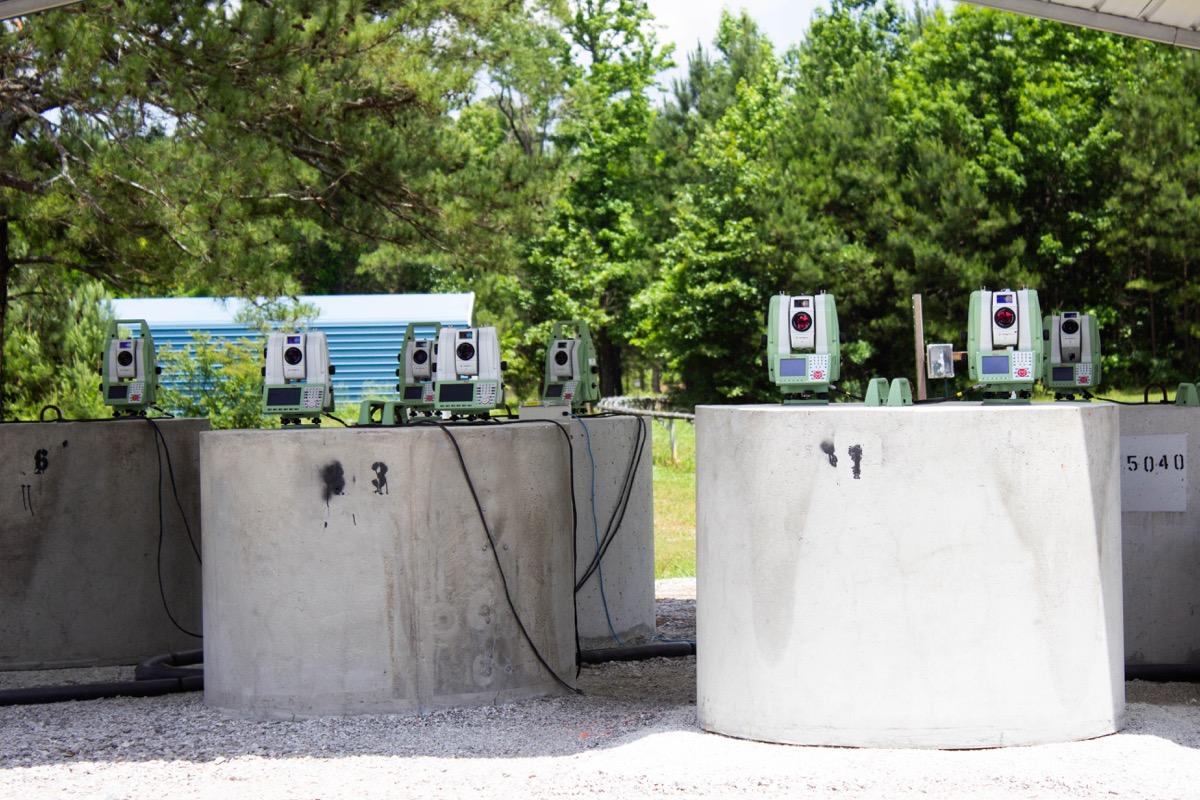NASA’s Megarocket Bet To Return To The Moon—And Beyond
17:30 minutes
 This story is part of our celebration of the 50th anniversary of the Apollo 11 mission. View the rest of our special coverage here.
This story is part of our celebration of the 50th anniversary of the Apollo 11 mission. View the rest of our special coverage here.
The Trump administration says it wants to go back to the moon—but how will we get there? You’ve seen the advances in spaceflight from private companies like SpaceX and Blue Origin. But a big part of the current U.S. plan for returning to the moon involves something called SLS, the Space Launch System—a megarocket assembled from a combination of parts repurposed from the Shuttle program, and new hardware.
John Blevins, deputy chief engineer for the Space Launch System, and Erika Alvarez, lead systems engineer for the Space Launch System Vehicle, join Ira to talk about the rocket’s design, capabilities, and NASA’s plans to use it to go back to the moon and beyond.
View photos from Science Friday’s field trip to NASA’s Marshall Space Flight Center in Huntsville, Alabama.



Invest in quality science journalism by making a donation to Science Friday.
John Blevins is the chief engineer for NASA’s Space Launch System Program at NASA Marshall Space Flight Center in Huntsville, Alabama.
Erika Alvarez is lead systems engineer for the Space Launch System Vehicle at NASA Marshall Space Flight Center in Huntsville, Alabama.
IRA FLATOW: This is Science Friday. I’m Ira Flatow coming to you from the US Space and Rocket Center in Huntsville, Alabama.
[APPLAUSE]
The Trump administration says it wants to go back to the moon. But how will we get there? You’ve seen the advances in space flight from private companies like SpaceX and Blue Origin. But a big part of the current plan for returning to the moon lies here in Huntsville with something called SLS, the Space Launch System. And it’s big, really big.
John Blevins is the deputy chief engineer for the Space Launch System at NASA Marshall Space Flight Center here in Huntsville. Welcome to Science Friday.
[APPLAUSE]
Erika Alvarez is lead systems engineer for the Space Launch System vehicle at NASA Marshall Space Flight Center here in Huntsville. Welcome to you.
[APPLAUSE]
John, for those people living in a cave and don’t know what the SLS is, give us in a nutshell what that is.
JOHN BLEVINS: It’s a very large rocket has the nutshell. But it is taking a lot of the historic components that we had in the shuttle. And we’ve made them a lot bigger. If you could overlay the two, you’d notice that we’re over 100 feet taller. And it’s the rocket we plan to go to the moon.
IRA FLATOW: Are their actual parts from the shuttle in it?
JOHN BLEVINS: There are actual parts from the shuttle. In fact, the engines that we’ll be flying, most of those engines have flight history in the shuttle. And there are other components as well, many other components as well.
IRA FLATOW: And the reason for that is why?
JOHN BLEVINS: Well, because it gave us a jump start. It was a good way to start the program so that we’d have flight hardware ready to go, proven hardware ready to go.
IRA FLATOW: And Erika, of course, saying that, there are some people who’d say, we had been to the moon. You know how to do that. Why not just dust off the old Apollo plans and get that rocket in the lobby filled up and send it to the moon?
ERIKA ALVAREZ: So there have been times in the past where we’ve tried to do that. We actually have a hard time sometimes finding the old drawings from Apollo of things that we built way back when. I know one of the things that we were kind of looking at here was the J2 engine. The J2 engine was something that, a few years back, we tried to go build a new engine. It was called the J2X. And when we found the actual old hardware, you could tell that it was hand blended, that during that time, the manufacturing techniques were different. You found things that were riveted, things that nowadays we will not be able to pass safety trying to do.
And so what we really did at that time was that we took that old heritage hardware, and we would scan it. We would do a white light scan. We would pull that into a CAD file. And now we had a mechanical drawing that we can now take to a robotic machine and actually use our new manufacturing techniques to actually build, with new materials, to be able to pass what we consider now our new standards.
IRA FLATOW: So the old stuff would not have passed modern safety standards or design? One of the things that people were pointing out to me in the Space to Rocket Park here was that the tooling on some of the engines were done by hand at the last minute.
ERIKA ALVAREZ: Yes. It was all very custom. In some cases where we were taking apart this hardware, you have to have really small fingers to be able to have the right tooling. You have to have custom tooling. So you have to actually design the tooling just to take the old heritage hardware apart.
So nowadays, we try to build things so they’re more standardized. We can use more of a kind of a streamlined flow when we start to put these things together.
And at the same time, we’re also trying to build a gateway that will actually orbit around the moon. And so you have to think long-term that when people go up there and they actually try to service this station that will be around the moon, you have to be able to have good tooling to be able to take things apart and fix them if you have to.
IRA FLATOW: All right. So you bring your tool box to the moon or around the moon with you?
ERIKA ALVAREZ: Actually nowadays, we build we bring a printer, a 3D printer where we can actually send up just a file. And we can print it while we’re up there, go ahead and have all the materials, print it out. And then the astronaut will take the new tool, say, yeah, this one works, it’s good, or no, send me a new file. I want to make a new one.
IRA FLATOW: John, is the new rocket able to go past the moon, have other uses besides just going to the moon?
JOHN BLEVINS: Well, yeah, the long-term intent, certainly, is to go beyond the moon. And in fact for science missions, we’ve got one booked right now that we plan to send to Europa. So it’ll send big payloads further and faster.
But we’re going to go to a further orbit than we did with Apollo, so 280,000 miles on the first mission next year. And so that will be further out than we’ve ever been.
IRA FLATOW: OK. So the time schedule is next year, you will have your first, what, proof of concept sort of mission?
JOHN BLEVINS: That’s right, yeah.
IRA FLATOW: People in it?
JOHN BLEVINS: No people in it next year.
IRA FLATOW: No people in it.
JOHN BLEVINS: Yeah. It’ll be two years later before we fly the first manned mission. November, 2020 is our target for launch.
IRA FLATOW: There were stories about the Apollo 10, they went all the way down to 40,000 feet above the surface. They didn’t actually land on the moon. And someone said, they didn’t give them enough fuel, because they would have if they had. Have you heard that story?
JOHN BLEVINS: We’ve heard that story, yeah. I’ve met Gene Cernan, and it’s probably true.
IRA FLATOW: Erika, you also need to deal with the human side of things. I’m thinking about, we all saw the movie The Right Stuff and how the astronauts were saying, you didn’t ask us about the human side. Why don’t you have a window here or a steering thing here for us? Do you talk to the astronauts more now and think of the human side?
ERIKA ALVAREZ: Yes. One of the things we do a lot is we take into account, when we talk about having a human rated vehicle is how will humans interact with this vehicle. How will they have contingency plans if things go wrong? Will they want to be able to steer this vehicle? If they want to steer that, how would we be able to enable our flight software to be able to do that.
So one of the challenging things about our jobs, really, John and I, is we get a lot of requests from our crew office, from our astronauts down in Houston. And we always have to think about, how can we meet those requests and at the same time still come up with something that we can verify as safe, it will be reliable, we can use it, and it will still be affordable. So that’s kind of our tight rope that we have to walk every day, because otherwise we’ll never be done customizing this rocket.
IRA FLATOW: What do you think about the private companies, Elon Musk, other people, who say, we’re going to get to the moon before you guys? Are they going to?
JOHN BLEVINS: Well, first I’ll say it’s an exciting time to be in the space business, right? There’s a lot a lot of rockets being built all at one time. First time that’s ever happened. During Apollo, it was just the Saturn, and it was all NASA rockets.
The current architecture includes the commercial rocket. It’s not for the manned piece leaving the Earth but for once we get to the moon and going down to the moon so. We plan on the part of the NASA architecture including some of those commercial launch vehicles.
It hasn’t all been worked out. So that’s been in a competition process right now.
IRA FLATOW: Is this mission, the 2020 mission and the one that comes after, is it bought and paid for? Is there the budget for it?
JOHN BLEVINS: Well, that’s a good question. I’m not sure they could have answered that question in the ’60s on Apollo either. I would suggest that there are discussions that continue. There’s some current budget negotiations.
And we don’t have a long-term budget through Congress. Every year, Congress decides what they want to give. So it’s not yet bought and paid for.
IRA FLATOW: You know, that’s one of the magical parts about the decade, the ’60 to ’70. It went through three presidents, and no one killed the program. We got to the moon right on schedule. Do you think something like that can happen today, considering the political climate, we have?
ERIKA ALVAREZ: I believe so. I believe so. One of the things that I’ve noticed when we go talk to schools is that a lot of people don’t realize out in the public that we don’t have a launch system to be able to take us to the moon anymore. It’s really a global and a national capability that we want to build.
And at the same time, it’s very enabling for some of these science missions that want to go farther, faster. They want to cut their mission time. And they want to be able to do new science to take us even beyond into interstellar medium.
So when we talk to scientists and they tell us about telescopes or they tell us about missions to Europa or they tell us even about getting back to the moon, and when can we do that? And can we start to build a sustainable environment and start to build habitats and expand on that?
I think that the space launch system, we’re very excited, is a big part of that. And so I think once people see that we build this capability that’s very flexible– I think right now, we do have a lot of the public’s support. And being able to see what it is that we can do and knowing that it was built here–
I think we’re up to at least 44 states that all contribute towards the Space Launch System within the United States. So it’s really our nation’s rocket. So we get a lot of support, at least from the public, when we talk to folks about it.
IRA FLATOW: Well, let’s talk to folks about it. Please come on up to the microphone. And we’ll take questions. Yes, sir.
AUDIENCE: Hi, there. A question about the SLS project lifecycle. I know there’s, as Flatow noted, companies like SpaceX has a fantastic and proven fly-back booster capability. The SLS currently doesn’t have that. But I’m wondering, are there plans to make it more cost-effective by increasing the amount of reusability of components and entire assemblies?
JOHN BLEVINS: Well, I’ll take part of that question. And then we can bounce it around. And I assume when you talk about reusability, you’re talking about boosters, because that’s pretty dramatic, yeah.
And so we had a long history in Shuttle, as you probably know, of recovering the boosters out in the ocean. And of course, it took that infrastructure to do that. I got to work on some of those things during that program and the following program, the Ares program. And so we had ships to tow the boosters. We had a refurbish facility.
It’s really about the infrastructure cross versus your flight rate. The intent of the SLS rocket is really to have a low flight rate with a lot of capability. It’s your 18-wheeler. It’s your large barge that you’re seeing down. It’s not a bass boat.
It is carrying larger capability than any of these other rockets we’re talking about by really more than two times. And that means a lot in space, because having multiple launches makes it a very complex mission. And so we can launch a lot in one mission.
But it is a big rocket. And so we’re not planning on reusing the boosters. Shuttle did that. They had a flight rate of up to 13 in one particular year. We’re looking at just under a year per flight, so maybe one flight per year getting started after a few years and then not a half flight rate after that. So for us, it would not be fiscally responsible, probably, to recover those boosters, just the infrastructure to do that.
But the other parts of that, the capsule, in this particular case, that is part that’s coming back. The Apollo capsule was not reusable. They’re spread across different museums, one here in this museum, the Apollo 16 capsule.
Our Orion capsule is set to be used for multiple missions. So there are parts that we’ve decided to use again. But it’s really case by case and what makes fiscal sense.
IRA FLATOW: Erika, anything to add to that?
ERIKA ALVAREZ: One thing I will say, kind of feeding off what John was saying, is that we really get pushed to get as much performance squeezed out of this rocket as we can. And so because of that, there’s only really two ways to work that. One, you either get more thrust, and you get more powerful engines. Or you get a lighter vehicle.
And so we really try to look at, if there’s areas that we can optimize the mass of the vehicle, we take that out. We say, do you need to have that bracket? Does it have to be that heavy? Do we have to have this on there? And we do this every single day.
And so when you do reusability you lose some of that function. And like John said, the first Space Launch System is going to carry over 26 metric tons of a capsule. But then the future SLS is going to carry a co-manifested payload, which is over another 10 metric tons plus everything to be able to encompass and do special services for that payload, a docking system, and a crew capsule. Nobody can push that much right now.
And so we know that our market, really, is pushing the most, pushing farther. And at our flight rate, just go ahead and get another one the next year.
IRA FLATOW: So I think a lot of people don’t know it that that rocket, that the first one, is going to be not the same as the subsequent ones. They’re going to be bigger, the subsequent ones.
JOHN BLEVINS: Yeah, I like to call it a star fleet, actually.
IRA FLATOW: Star fleet?
JOHN BLEVINS: Yeah.
ERIKA ALVAREZ: We used to joke around about that.
JOHN BLEVINS: I jokingly call it the star fleet. I shouldn’t say that on radio. It’ll probably be not–
IRA FLATOW: Not the Space Force?
JOHN BLEVINS: Yeah. But we have seven different booked configurations right now that curious about to 2030. Some of that’s based on obsolescence, making better boosters and all that.
But to add to that question too, you can imagine, if you’re going to bring something back, those design requirements, just like Erika’s saying, that mass becomes different. And in fact, when we did the boosters for Shuttle, the design requirements were based on reentry more than they were ascent for the Space Shuttle.
IRA FLATOW: You’re an engineer. Do you build in a little extra for maybe someday you want to do something a little more, and then you have that capability?
JOHN BLEVINS: Always.
ERIKA ALVAREZ: Always.
JOHN BLEVINS: Always. But at some point, it has to stop. Part of Erika’s job is making sure that churn stops.
IRA FLATOW: [CHUCKLES]
Just so many options you can put on the vehicle. I’m Ira Flatow. This is Science Friday from WNYC Studios here in Huntsville, talking about upcoming space missions. Let’s go back to the audience. Yes, sir?
AUDIENCE: Yeah. If there is some sort of unforeseen problem that develops with SLS, is there discussion about some fallback positions as far as size or capability, say, to the 80% or 90% level?
JOHN BLEVINS: And you’re talking about getting a lunar mission in case SLS, as a program, has a problem?
AUDIENCE: Any type of mission, are there fallback positions?
JOHN BLEVINS: Well, right now, the only capsule that we have, the only human rated capsule, really, for deep space, something like the moon, is our Orion capsule. So we’re in a position right now as a nation, as an agency, where really, SLS is the only one that can push that. The others don’t have that payload capability.
There currently is not a fallback, if you’re asking can we create another capsule and launch it on a different rocket.
AUDIENCE: No, I was really talking about the rocket itself, if there was a fallback position or a smaller capability rocket.
JOHN BLEVINS: That’s really a good question. This may not answer your question the way that you think. But I would suggest to you this first vehicle that we’re flying, in some ways, is our fallback.
When we started the program, we decided to fly this what we’re calling Block 1. And it is a symbol of a lot of heritage parts. And it’s lesser capability. Although, as I mentioned earlier, it’s more than twice what you can get on any other rocket as far as to the moon, well over twice.
And so the long-term rocket has a second stage. And that’s really where we’re aiming. That is the rocket that we consider SLS at NASA. This Block 1 rocket is the backup plan.
And Ira, to one of the things you said earlier about success and all that, one thing that isn’t well known is, most of the parts are waiting for us. The upper stage that is on this rocket is sitting at Kennedy Space Center under purge. And all the booster segments that we plan to fly are casts.
So there’s a lot of hardware waiting for the new hardware, which is just about to come out of the factory. And we’ve got a lot of testing. The reason that it’ll be 18 more months is there’s a lot of verification testing we want to do to make sure the rocket’s ready to fly.
IRA FLATOW: Yeah. I was wondering how you go from nothing to a rocket flying in 18 months. And now you explain that is the parts are there, waiting to go.
JOHN BLEVINS: They’re already at Kennedy Space Center, waiting for the main core of the rocket.
ERIKA ALVAREZ: And the mobile launcher too is brand new. And that’s also sitting out there at Kennedy Space Center, going through all its verification testing. And it’s going to be ready to go when we get the rocket there.
JOHN BLEVINS: Yeah, it kind of goes back to the question you asked earlier. This rocket already transcends one presidency to another presidency.
IRA FLATOW: Right.
JOHN BLEVINS: We started this in late 2011. And we’ve been working on it ever since.
IRA FLATOW: Erika Alvarez is lead systems engineer for the Space Launch System’s vehicle at NASA Marshall Space Flight Center here in Huntsville. Thank you for taking time to be with us today.
[APPLAUSE]
John Blevins, deputy chief engineer for the Space Launch System at NASA Marshall Space Flight Center here in Huntsville. Thank you. Thank you for being here today.
[APPLAUSE]
That’s about all the time we have. Our heartfelt thanks to WLRH for hosting us and to everyone at the station for making us feel so welcome. Thank you, special thanks to WLRH’s Rebecca Goodwin, Nate Emery, and Brett Tannehill and to Dr. Deborah Barnhart, Dr. Kay Taylor, and all the staff here at the US Space and Rocket Center for making this wonderful evening possible. Thank you all.
[APPLAUSE]
In Huntsville, Alabama, I’m Ira Flatow.
[APPLAUSE]
Copyright © 2019 Science Friday Initiative. All rights reserved. Science Friday transcripts are produced on a tight deadline by 3Play Media. Fidelity to the original aired/published audio or video file might vary, and text might be updated or amended in the future. For the authoritative record of Science Friday’s programming, please visit the original aired/published recording. For terms of use and more information, visit our policies pages at http://www.sciencefriday.com/about/policies/
As Science Friday’s director and senior producer, Charles Bergquist channels the chaos of a live production studio into something sounding like a radio program. Favorite topics include planetary sciences, chemistry, materials, and shiny things with blinking lights.
Katie Feather is a former SciFri producer and the proud mother of two cats, Charleigh and Sadie.
Ira Flatow is the founder and host of Science Friday. His green thumb has revived many an office plant at death’s door.